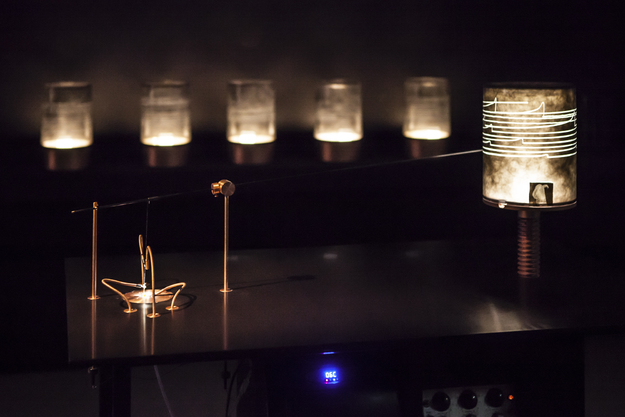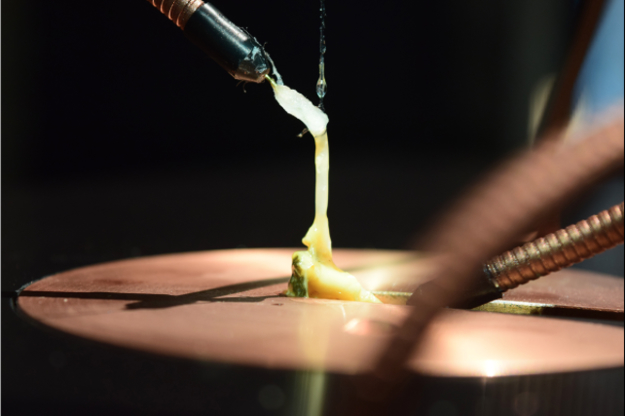Miserable Machines: Soot-o-Mat
Soot-o-Mat is the first in a series of the 'Miserable Machines’ that the artist intends to make. These machines are hybrids between the technological and the biological. However, Špela explains that ‘to a certain extent they are unsuccessful hybrids’ as their aim is banal but a whole organism is sacrificed in order to fulfil that aim.
The name for the project comes from the soot residue that is burned onto the glass cylinders (created by burning 3 or 4 tea lights and rotating the glass cylinder in the flames), and the automatic nature of the contraction and expansion of the mussel that creates a pattern in the soot.
Špela explains that the aim of the machine is to make ‘nice patterns on glass cylinders’ in order to create lampshades and a ‘final resting place of the mussel.’ It is in this way that she plays the current trend of 'hand-made, unique items that have a high price.’

How it works
A small dissection is performed on the mussel to remove the part that closes the shell of the sea creature. The mussel is then strapped to the machine lever. One end of the lever draws on the slowly rotating and rising glass cylinder; the other end is attached to the mussel. It takes about 15 minutes for one full rotation of the glass cylinder. In six hours the cylinder will move just 20 cm upwards, while the contractions happen once roughly every 20 minutes.
The mussel contracts and relaxes with electro-stimulation felt by two attached electrodes. When the mussel relaxes, the lever makes contact with the stimulator, resulting in the electrocution of the mussel and its subsequent contraction. This contraction and relaxation is what draws the patterns on the glass.
When a mussel is removed from its shell it still has some energy stored and depending on how quickly it relaxes, it can continue working for another five hours. To maintain this working ability, the mussel is drip fed salt water and kept at 5 degrees by a small fridge.
Once the life of the mussel is complete and the drawings have been made, the soot lines are fixed and the cylinder is turned into a lampshade. Špela explains that this is 'a sharp commentary of obsolete but still persisting modes of production with blatant exploitation of living systems.'

Miserable Machines
This series is an ambitious framework in which Špela aims to explore the principle of manual and biological abuse through different time periods. It is the juxtaposition of Capitalism with anonymous living materials. The mussel in this case symbolising the ‘alienated worker’
Part one is dedicated to the beginning of capitalism and 19th century apparatus, which led to the changed attitudes of 20th century Capitalism. Špela also wants to explore the world of 1950s kitchen appliances designed to make life easier but actually work on the same principle of the invasion of the biological and manual. The final aspect of her project will explore the 21st century and its senseless ‘digital reality’ of making money from a surplus of data without mental investment. It is this hack of the ‘system’ that Špela wants to probe.
At Mediamatic
The work is currently installed in the Mediamatic ETEN restaurant. There is, unfortunately, quite a ‘high death toll’ as not all mussels work after dissection and merely die. It is ‘not the purpose of the project to kill animals’ but Špela does emphasise that the general mentality is that ‘some animals are less worthy of consideration than others.’ She states that mussels are to most people like this, being bought in a large pack and thrown in boiling water before eating them without a second thought.
When faced with an electrocuted mussel powering an artwork, a different kind of empathy rises, but Špela would like to remind the public of the general mentality towards mussels when it comes to boiling and eating them.


About the Artist
Dr. Špela Petrič (1980) is originally from Ljubljana, Slovenia. She is currently completing her residency in Amsterdam, supported by the Amsterdams Fonds voor de Kunst, working alongside Mediamatic, the Waag Society and Vrije Universiteit Amstedam. She is also a member of the open source biological art project, Hackteria.
Špela's artistic practice combines natural sciences, new media and performance. She is interested in anthropocentrism; the reconstruction and re-appropriation of scientific methodology; living systems in connection with inanimate systems; and terra-biology.
While working towards a critical discourse between the professional and public spheres, she tries to envision artistic experiments that produce questions relevant to anthropology, psychology, and philosophy. She is particularly devoted to giving art/science workshops to both inform and sensitise the public.

Information
Miserable Machines: Soot-o-Mat at Mediamatic ETEN.
Check our calendar for extended opening hours and events.

